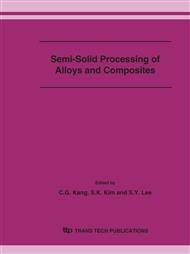p.24
p.34
p.44
p.54
p.58
p.64
p.68
p.72
p.76
Design and Production of New Aluminum Thixotropic Alloys for the Manufacture of Structural Components by Semisolid Die Casting
Abstract:
Semi-solid processing is nowadays a powerful technology for the realization of structural components; in addition to the increase in their mechanical properties, due to the globular structure instead of the dendritic one, further developments are most likely to be expected from alloy chemical composition adjustments in order to achieve higher performances compared with the industrially used A356 and A357. Aim of this research is to try to set up new aluminium alloys for semisolid foundry applications, starting from the standard Al-Si system, at the base of all known casting processes. Different chemical compositions, based on either foundry or wrought Al alloys, have been investigated by means of computational thermodynamics (Pandat®), producing quantitative data about solidus-liquidus interval, solid fraction as a function of temperature, phase diagrams i.e. potential for age hardening, etc.. Some selected alloys, fitting the needs of good castability, proper concentration of hardening elements in the alpha phase and, obviously, easy production of feedstock material have been mechanically stirred by means of an experimental apparatus designed and self-constructed in the foundry laboratory of the university; the effect of different stirring tool configurations on the semi-solid state obtainment has also been assessed. Subsequently, the manufactured alloys have been reheated and cast into a simple die, properly designed, for the production of small samples. Microstructural investigations have been done on the stirred alloy (before and after re-heating), on the as cast and the heat treated samples to evaluate the efficiency of the designed system and of the defined alloys. Experimental tests on the processed alloys have been carried out by means of an instrumented crucible in order to verify the predicted thermodynamic properties supplied by simulation study (i.e. fs-temperature curve).
Info:
Periodical:
Pages:
58-63
Citation:
Online since:
October 2006
Authors:
Keywords:
Price:
Сopyright:
© 2006 Trans Tech Publications Ltd. All Rights Reserved
Share:
Citation:


